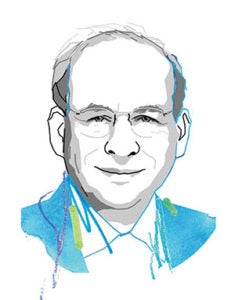On Being Bold
President David W. Leebron discusses the goals of the Be Bold capital campaign, which launched in October with a goal of $2 billion.

In October, during homecoming and reunion weekend, we formally launched our Be Bold campaign with a goal of $2 billion, twice the goal of our last campaign. The theme was taken from President John F. Kennedy’s iconic speech about going to the moon, delivered in September 1962 in Rice Stadium, just before the 50th anniversary of the first classes at Rice. Kennedy began by noting the huge investment that would be required to achieve that goal, and then proceeded:
But if … we shall send to the moon, 240,000 miles away from the control station in Houston, a giant rocket more than 300 feet tall, the length of this football field, made of new metal alloys, some of which have not yet been invented, capable of standing heat and stresses several times more than have ever been experienced, … on an untried mission, to an unknown celestial body, and then return it safely to Earth … — and do all this, and do it right, and do it first before this decade is out — then we must be bold.
What did he mean by bold? Perhaps a little etymology is in order. The word “bold” is derived from “bald.” No, that’s not the description of my hairstyle, but rather the German word bald, meaning “soon.” In other words, bold incorporates a sense of urgency and speed, as well as doing things differently, in an unexpected way, and courageously. In Kennedy’s case, that sense of urgency was driven by a combination of the breakneck speed of the evolution of knowledge and the fierce competition to apply that knowledge, in some cases for national advantage. Speaking of the pace of human and scientific progress, Kennedy said:
This is a breathtaking pace, and such a pace cannot help but create new ills as it dispels old, new ignorance, new problems, new dangers. Surely the opening vistas of space promise high costs and hardships, as well as high reward. … So it is not surprising that some would have us stay where we are a little longer to rest, to wait. But this city of Houston, this state of Texas, this country of the United States was not built by those who waited and rested and wished to look behind them.
We see evidence of boldness every day at Rice. We see it in the bold research of faculty to improve human knowledge, health and opportunities. We see it in the bold expansion of our university, both on its campus and even more dramatically through online degrees, programs and courses. We see it in our bold financial aid program, The Rice Investment, which we see increasingly emulated.
He noted that such efforts are accompanied by burdens, hardship and disagreements. Indeed, in the structure of his speech, the call to boldness quoted above immediately followed the paragraph that began “to be sure, all this [expenditure on space technology] costs us all a good deal of money,” and laid out some of the costs. He noted that at the time they were already spending $5.4 billion ($47 billion in today’s dollars) per year.
And this brings us to the need for a campaign, namely to make the investments that make our bold visions possible. I return often to Kennedy’s speech because in my view it applies so eloquently to our university’s mission and ambitions as well:
[O]ur leadership in science and in industry, our hopes for peace and security, our obligations to ourselves as well as others, all require us to make this effort, to solve these mysteries, to solve them for the good of all men, and to become the world’s leading space-faring nation. … We set sail on this new sea because there is new knowledge to be gained, and new rights to be won, and they must be won and used for the progress of all people.
A similar spirit motivates our university across a wide range of endeavors, including space exploration, and Rice has been bold and ambitious from the beginning. The first board of trustees hired from Princeton the young professor Edgar Odell Lovett, who in turn embarked upon a world tour to visit the best universities across the globe. When it came to the final choice of the campus location, the trustees reconsidered the plan to locate the university on a downtown Houston site of about 12 acres, instead choosing a site of almost 300 acres beyond the edge of the town of then about 80,000 people as more fitting its bold aspirations.
We see evidence of boldness every day at Rice. We see it in the bold research of faculty to improve human knowledge, health and opportunities. We see it in the bold expansion of our university, both on its campus and even more dramatically through online degrees, programs and courses. We see it in our bold financial aid program, The Rice Investment, which we see increasingly emulated. We see it in our athletic ambitions, despite our small size, now given new impetus through a new athletic conference membership. And we see it reflected in our two largest gifts ever to the university made this past year — one to build new frontiers in our understanding and design of materials, and the other to build a student center that will set a new standard in supporting student life and opportunity. And we see it in the bold determination of our students to make their own contributions.
As we approach the 60th anniversary of Kennedy’s speech, I hope you will join us as we celebrate what our university has become, preserve the very best of our attributes and values, and lay the groundwork for a bold future in the decades ahead.
